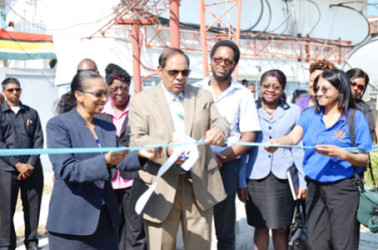Ending a controversial five-year multimillion contract with the Ramroop Group-owned TVG, the government yesterday announced that the state-owned National Communications Network (NCN) will be providing the satellite uplink for the Guyana Learning Channel.
Prime Minister Moses Nagamootoo underscored the importance of the satellite uplink and distribution system as part of the country’s defence mechanism and overall communication to the citizenry.

“At a time when all of Essequibo is being claimed (by Venezuela)… We can send the message that Guyana is ours. All of Guyana is ours. Our Essequibo and the rest of Guyana, so that now we have capacity and this connectivity, as I see it, is not only in keeping with the promise made to our Guyanese people but this is also securing defence capability because the first line of defence, in a situation like ours, is the ability to communicate in clear simple language ‘Not one Blade of Grass not one cuirass’ and that is what we need to tell Guyana and this connectivity today would give us that capacity,” the Prime Minister said at the commissioning of the facility at NCN’s Homestretch Avenue Headquarters.
The Ramroop Group contract, worth $185 million, was signed between the former PPP/C government and TVG in 2010 to provide the satellite uplink facility. The government was paying TVG $3.6 million per month in a bundled package for services inclusive of the unlinking cost to the NSS-806 satellite.
In October last year, it was reported that equipment capable of performing the same service was discovered at NCN. However, Minister of Education Dr Rupert Roopnaraine had told this newspaper that TVG would continue to provide satellite uplink services for the Learning Channel until the end of February while NCN worked out its “issues.”
Nagamootoo had recently said that these issues had been resolved, equipment had been installed and was “ready to go countrywide.”
He said that while the February deadline was not met, he was glad that “in March we are marching.”
He had told the National Assembly that two community radio stations in Mabaruma and Lethem with the capacity to link to NCN radio were to be operationalised in 2016 at a cost of $45 million.
Further allocations were made, according to Nagamootoo, to build an access road to the Voice of Guyana (VOG) transmission facility at Onderneeming, West Bank Demerara, so that a previously unused generator could be operationalised.
This position, he echoed yesterday and stressed that all of Guyana will now be able to access the broadcast feed. He hopes that the upcoming Guyana’s 50th anniversary celebrations will be broadcast live.
He pointed out to NCN management that they can now also maximise the use of the satellite link and tap into international advertising as a means of generating income.
The Prime Minister, in thanking persons who contributed to the launch, credited Technical Director of the project Dr. Seeta Shah Roath for convincing government that the project could be achieved.
Dr Roath said yesterday that The Guyana Learning Channel Trust creates and acquires its formal and informal curriculum-based educational content at the National Centre for Educational Resource Development (NCERD), as part of the Ministry of Education’s Distance Learning Multimedia output.
“The audio video signal of this content is transmitted terrestrially from our Kingston master site with a power that allows the signal to be received by a receiving antenna at the site of a teleport within Georgetown. Having received that signal, it is transported to a satellite via an Earth Station Teleport capable of transmitting audio-video signals. The selected satellite in turn broadcasts that signal with a known frequency that can be picked up with relevant receiving systems along the footprint of the particular satellite, anywhere in Guyana, South and North America etcetera,” Dr Roath explained.
“This reach was confirmed in the past as we have even received requests for content usage, accessed directly from the satellite – from Finland, the United Kingdom, Brazil and Suriname to mention a few. There have also been requests for international advertising on our station through our satellite broadcasts. Of course we are non-commercial, so did not follow up on those. And our locally produced content is registered under Creative Commons and can be used for educational purposes with no copyright issues as long as it is shown intact with no changes whatsoever,” she added .
She said that in the second phase of this project, her group will develop the capability of transporting radio signals in Region 1 as the Ministry of Education is preparing to continuously transmit the Interactive Radio Broadcasts (IRI) and Broadcasts to Schools in Port Kaituma and possibly Matthews Ridge. NCERD has also offered to facilitate NCN at some of their locations for both radio and television if they so desire.
“NCN will also be collaborating with international consultants to expand the current teleport system just completed, now capable of transmitting one channel, to transmitting multiple channels thus facilitating a countrywide reach of both TV and Radio for NCN. Through training and additional equipment, NCN will then have the capability to operate a full multichannel teleport to the satellite for its own use and possibly other customers if they so desire,” she said.





